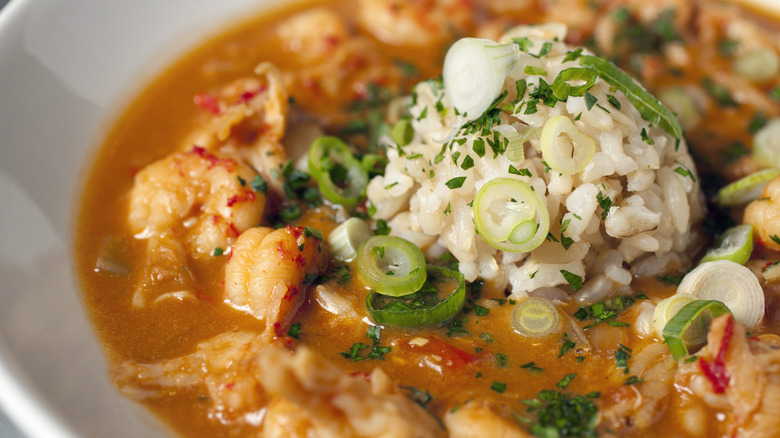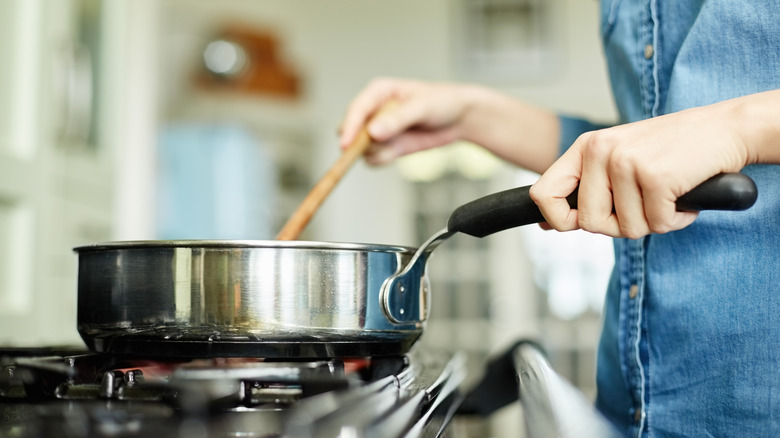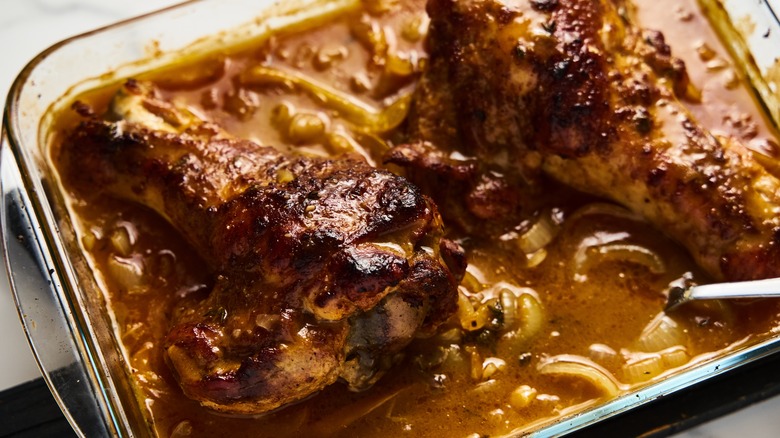What Is Smothering And What's It Got To Do With Cooking?
Some cooking terms are not as intuitive as others. Similar to the mystifying term "folding" — the butt of a joke on the TV show "Schitt's Creek" — the term "smothering" may conjure confusing images that have little to do with cooking. Thankfully, the word's use in the kitchen is far more benign (and delicious).
The term derives from the French word "étouffée," meaning "smothered." The dishes themselves show influences from not only French but West African and Creole cultures, too. Nowadays, "smothered" is a more commonplace descriptor on menus across Southern tables, clueing diners into the fact that their chicken, shrimp, mushrooms, and more are going to arrive swimming in a flavorful gravy. Some adventurous cooks even apply the idea to coating burritos.
Louisiana natives and soul food experts most likely recognize the term étouffée, however, and know the dishes themselves are utterly dependent on personal tastes and family recipes. Smothering is a popular treatment in Cajun and Creole cuisines, as well as in the Deep South. As with any beloved food, the meal looks different in every home, but one thing is certain: Smothering food means it will arrive drenched in a thick, tasty sauce that's more than the sum of its parts.
What makes smothering different?
A point of pride when it comes to étouffée and smothered dishes is that the sauce is thick, rather than thin and watery, as a stew can be. In some traditional New Orleans dishes, light proteins only get a quick cook as they're heated in the sauce, rather than stewing for hours. However, other chefs liken the technique to braising, as more robust vegetables, store-bought meats, and even wild game get cooked slowly in the coating.
In Louisiana, where étouffée dishes represent comfort food and have a place during holiday celebrations like Mardi Gras, cooks often lean on a homemade roux and the "holy trinity" to build their meal. A roux, another French term, is a mixture of fat and flour heated together on the stove to thicken sauces. And the "trinity" is a New Orleanian term that refers to a mirepoix of onion, green bell pepper, and celery. The aromatics are diced and sauteed to form the basis for many Cajun and Creole dishes.
Most important in developing the sauce is taking the time to ensure browning — or Maillard reaction. This step occurs when caramelizing vegetables and meats, but it also develops when heating the roux. Though the floury mixture is not a requirement, it does result in a sweet, nutty flavor and thickened, gravy-like texture. A rich gravy is the key to any smothered meal.
How to build a smothered dish
In NOLA, classic smothered dishes include Louisiana shrimp étouffée, as well as crawfish étouffée. The sauce comes together with a combination of a roux, the Holy Trinity, shrimp or crawfish stock, and plenty of seasonings. The delicate seafood gets a quick warm in the gravy before serving atop rice.
However, some chefs take a different approach. They might incorporate red bell pepper or tomato paste for sweetness and color, or venture into using poultry or game, rather than shellfish, as their protein. Louisianans also debate the proper shade of the roux, with some opting for a lighter brown to ensure maximum thickness and gentle warmth, and others heating their mixture to a deep brown for intense flavor. The traditional rice accompaniment also has a modern substitute in some households: cauliflower rice.
Even the roux itself is up for interpretation and personalization when other proteins and vegetables are involved. Modern Southern dishes including smothered chicken, pork chops, steak, cabbage, and mushrooms will forgo the roux to create a gravy made from aromatics and the juices in the pan. Others swap in a cornstarch slurry or canned creamy soups as a thickener. Regardless of how cooks develop their dishes, the heartier mains allow cooks to take advantage of the smothered preparation and slowly braise their meals to bring out all those saucepan flavors.



